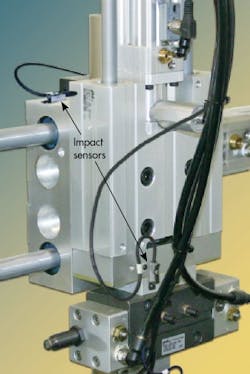Almost every machine in motion involves impact. In some, the impact is so slight that it might be ignored. In others, proper lubrication, bumpers, or shock absorbers can control impact. But if something unexpectedly goes wrong or mechanisms wear on some machines, severe impact (or too little impact) can produce bad parts — or in serious cases, heavy impact can damage the machine itself.
Where data about impact is important, the new Series KG Impact Sensor, from PHD Inc., Fort Wayne, Indiana, easily attaches to any moving part of a machine or device via a bracket (included) or band clamp. Then, using single-axis/bi-directional sensitivity, the sensor monitors impact and serves as a predictive maintenance device by detecting changes in impact force. It is available factory preset or field programmable. The output signal is fail-safe, and a multi-color LED on the sensor provides visual monitoring.
A PLC can interpret the sensor’s signal to warn of erratic operation. Depending on how it it programmed, the PLC can alert personnel in the event of a machine crash and stop a machine to prevent additional damage. Add an accompanying KG Programmer to the sensor, and the user can define rewriteable setpoints for single- or dual-point operation. The sensor then can count impacts or extreme vibration (<400hz), and monitor centripetal forces. The programmer also reads the last impact (a feature that is ideal for benchmarking). A single programmer has the ability to service an unlimited number of impact sensors throughout an entire plant.
Protected to IP67, the impact sensors operate over a temperature range from -32º to 176ºF. Their measurement range is 5 to 120g, with ±5g accuracy and 1g repeatability. Response time is 10 ms max. The sensors require a 10- to 30-VDC supply and their maximum output current is 20 mA.
For more information on the Series KG impact sensor, call PHD Inc. at (260) 747-6151 or visit click here.
About the Author
Richard Schneider
Contributing Editor
Contributing Editor, has been affiliated with Hydraulics & Pneumatics for more than 30 years and served as chief editor from 1987 through 2000. He received a BSME from Cornell University and also completed additional courses at the Milwaukee School of Engineering. His diverse background in industry includes ten years with a fluid power distributor and a variety of other professional positions. He has also been active with the National Fluid Power Association and Fluid Power Society.

Leaders relevant to this article:


